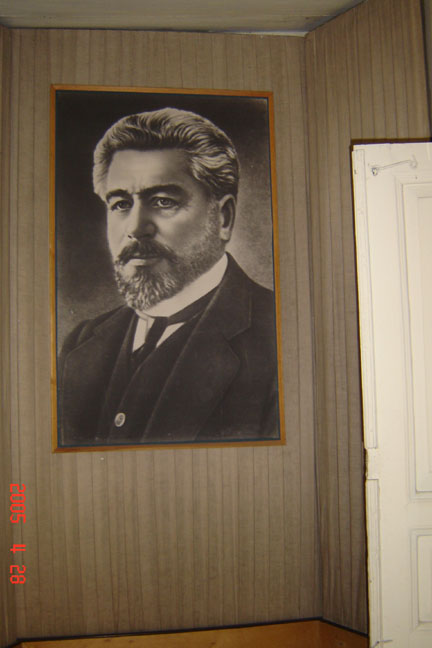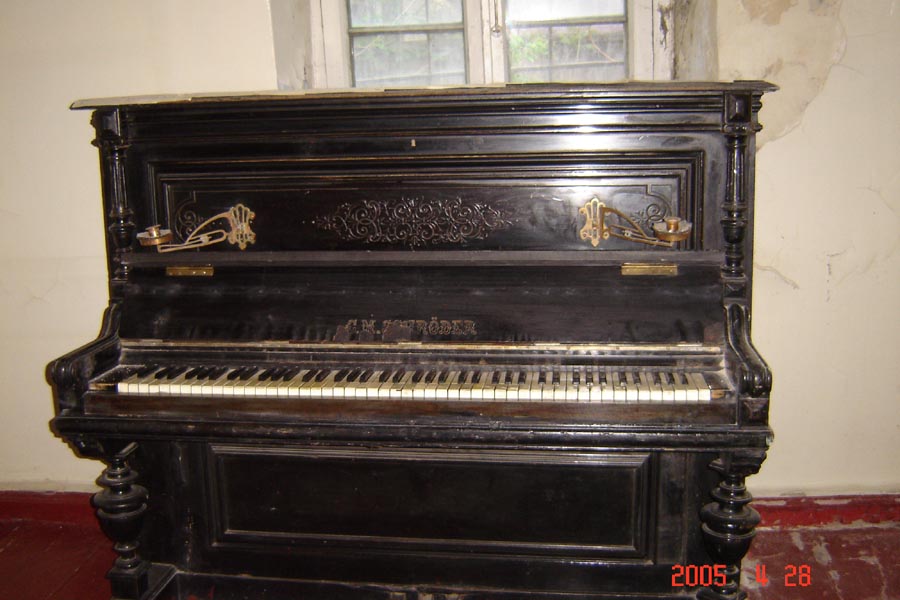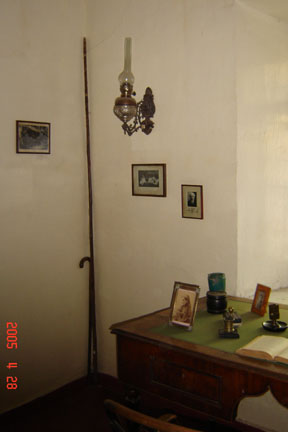
(© R. Bedevian/Groong)
Armenian News Network / Groong
May 25, 2004
Travel Wire
By Ruth Bedevian
ETCHMIADZIN, ARMENIA
It was a sunny day with a perfect dose of April breeze as we alit from our cab at Komitas Square and entered the courtyard of the Hovhannes Hovhannesyan House Museum in Etchmiadzin (formerly Vagharshapat), Armenia. Mariam Maghakian, a veteran docent, introduced herself and invited my friend, Gohar, and me to explore the home. It is somewhat reminiscent of the architecture of the Aksel Bakuntz House Museum in Goris in that it was built in traditional Armenian design of its day with a large wooden porch and thick stone walls. She led us through the courtyard which was overgrown with vegetation, including lilacs in bloom. It was a charming setting and in an earlier time I imagined it more gently groomed. We passed the statue of the former owner - foremost a teacher, also a poet, linguist, and translator - Hovhannes Hovhannesyan (1864-1929.)

|
|
Hovhanes Hovhanessian (© R. Bedevian/Groong) |

|
|
H. Hovhanessian's Piano (© R. Bedevian/Groong) |
She went on to summarize. Hovhannes Hovhannesyan was part of the Modern Armenian Literature movement which arose at the end of the 19th century. He, along with Abovyan, Nalbandian and Raffi, wrote in modern Armenian to awaken the common people. Together with the Russian linguist and writer Valeri Brusov, he was one of the first to unearth medieval Armenian secular poetry, still buried in old manuscripts, and stir the interest of his students, colleagues, intellectuals at large and the Russian readers. They collaborated on translations of works by Schiller, Pushkin, Goethe, Nekrasov, Ibsen and Hainze. Hovhannesyan's translations of Shakespeare [from Russian into Modern Armenian] are considered in linguistic circles to be extremely fine and accurate. In addition to Russian, Hovhannes Hovhannesyan also translated from French and German into Armenian to expose the Armenian people to international literature.
Although he worked in Baku as an Inspector of Schools and traveled very briefly, visiting Eastern European cities, and briefly taught at the Nersessian School in Tbilisi, the majority of his lifetime was spent in Etchmiadzin where he was devoted to teaching generations of gifted students at the Gevorgian Seminary. His literary works are primarily poetry, of which several pieces have been translated into English. `Song,' `The Poet' and `New Spring' appear in Alice Stone Blackwell's Armenian Poems Rendered into English Verse (1917). His friend and colleague, Valeri Brusov, edited and translated thirteen of Hovhannesyan's poems into Russian.
Words of tribute by prominent Armenian writers are decoratively displayed in glass cases. My friend, Gohar, loosely translated one in particular at my request. Quite eloquent in English, one can imagine Avetik Isahakyan's original Armenian. ` There are people who are gone from us but who are always present in our hearts and who are remembered with gratitude and endless love. One of the brilliant creators of our new poetic literature, Hovhannes Hovhannesyan is one of these eternal beings. I am forever indebted to this great `priest' of poetry.' A former student of Hovhannesyan, Isahakyan grew to be a grealy revered poet himself and therefore his homage to his teacher is particularly poignant.

|
|
Hovhanessian's Fishing Pole (© R. Bedevian/Groong) |
As part of the intellectual circles that created the new socialist republic circa 1918-1920, he was among those who, most probably, would have been targeted by Stalin as a counter-revolutionary, but he died seven years before the great purges that began in 1936 which erased the intellectual class in Armenia - Yessayian, Charents, Totovents, Bakountz among them. Mariam Maghakian informed us that Hovhannesyan's parents and a few of his eight children (of which there were four daughters and four sons) are buried near Hripsime and that his youngest sister is buried in Moscow. Today there are no living grandchildren.
I left the Hovhannesyan home with a deep sense of longing, with a yearning for a time when eight children filled the rooms with chatter and laughter, with a pining for a time when the master of the house retired to his study and read, wrote, and translated classics to enlighten an Armenian peasantry, and with a hunger for a time when Komitas, the student, played melodious tunes on a piano that has now become a relic.
-- Ruth Bedevian continues her visits to Armenian authors' House Museums around Armenia. Her articles in this series are at: http://www.groong.org/orig/armeniahousemuseums.html
|
Redistribution of Groong articles, such as this one, to any other
media, including but not limited to other mailing lists and Usenet
bulletin boards, is strictly prohibited without prior written
consent from Groong's Administrator. © Copyright 2004 Armenian News Network/Groong. All Rights Reserved. |
|---|